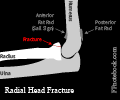II. Epidemiology
III. Mechanism
- Fall on Outstretched Hand with elbow extended and Forearm pronated
- Direct blow to lateral elbow
IV. Symptoms
- Painful and limited Forearm movement (esp with extension and supination)
V. Exam
- See Elbow Exam
- See Forearm Fracture
- Evaluate elbow stability with valgus and varus stress testing (see Elbow Exam)
- Assess for Medial or lateral collateral ligament injury
VI. Signs
VII. Imaging
-
Elbow XRay
- See Elbow XRay
- Sail Sign (Anterior Fat Pad Sign)
- Posterior Fat Pad
- XRays are often normal initially (have a high index of suspicion)
- Special Views
- Radial Head-Capitellum View
- Isolates radial head without overlapping shadows
- Radial Head-Capitellum View
- Diagram
VIII. Complications
IX. Evaluation: Mason Classification
X. Indications: Orthopedic Referral
- Mason Type 2-4
- Abnormal varus or valgus testing
- Suggests medial or lateral collateral ligament injury
XI. Management: Adult
- Displaced or comminuted Radius Fracture (Mason Type 2-4 or more)
- Initial
- Mason 2 may be immobilized with sling
- Mason 3-4 are immobilized with a posterior splint
- Mason Type 2 may be treated surgically (if impaired range of motion) or conservatively
- Mason Type 3-4 are treated with surgical excision of radial head or ORIF (preferred within 24-48 hours)
- Initial
- Non-displaced or minimally displaced Radius Fracture (Mason Type 1)
- Conservative Management
- Initial Option 1: Immobilize for 3-7 days with elbow at 90 degrees
- Light posterior splint or
- Sling with comfort
- Initial Option 2: Early mobilization after first 48 hours of immobilization
- Associated with decreased pain and better initial function
- Similar healing rates to option 1
- Continue Sling for 1-2 weeks as needed after splint removed
- Initial Option 1: Immobilize for 3-7 days with elbow at 90 degrees
- Exercises
- Relief of severe pain from swelling
- May aspirate Elbow joint at posterolateral triangle, but lack of evidence for benefit
- Foocharoen (2014) Cochrane Database Syst Rev (11): CD009949 [PubMed]
- Follow-up at 3-4 weeks
- Repeat Elbow XRay
- Expect return to full use at 3-4 weeks
- Indications for extended restrictions for additional 2-3 weeks
- Medial or lateral collateral ligamentous instability
- Less than full range of motion
- Decreased strength
- XRay with incomplete healing
- Conservative Management
XII. Management: Child
- Non-displaced Fracture and <15-30 degrees angulation
- Management as for non-displaced Fracture in adults
- Displaced Fracture >50% or >15-30 degrees angulation (60 degrees may be acceptable in some cases)
- Reduction
- Closed
- Open reduction and internal fixation (ORIF)
- Radial head is never excised in growing child
- Epiphysis removal results in unequal Forearm growth
- Reduction
XIII. Prognosis
- Non-displaced Fracture or effective early reduction
- Expect some loss of elbow extension
- Minimal or no functional Impairment expected
- Delayed effective management of displaced Fracture
- Permanently restricted elbow Range of Motion
- Traumatic Arthritis
- Fracture fragments act as nidus for calcification
- Myositis Ossificans ensues in anterior elbow region
XIV. References
- Riveros (2025) Crit Dec Emerg Med 39(5): 25-6
- Black (2009) Am Fam Physician 80(10): 1096-102 [PubMed]
- Liow (2002) Injury 33(9): 801-6 [PubMed]
- Patel (2021) Am Fam Physician 103(6): 345-54 [PubMed]

